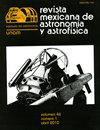马克西在六年中看到的CEN X–3
IF 1.7
4区 物理与天体物理
Q3 ASTRONOMY & ASTROPHYSICS
Revista Mexicana de Astronomia y Astrofisica
Pub Date : 2022-07-23
DOI:10.22201/ia.01851101p.2022.58.02.15
引用次数: 1
摘要
本工作的目的是利用MAXI/GSC观测策略研究Cen X-3的光曲线和轨道相位谱。这些研究可以界定恒星风的性质及其与致密物体的相互作用。通过对光曲线的分析,我们估计了双星系统的轨道周期,并在Psuperb=220±5天的超轨道周期附近发现了可能的QPO。在2.0–20.0 keV的能量范围内,提取并分析了轨道相位平均光谱和相位分辨光谱。两个模型已经令人满意地描述了光谱,一个是热电子上冷光子的部分吸收康普顿化加上幂律,另一个是部分吸收黑体加上幂定律,这两个模型都通过添加高斯线进行了修改。X射线光度在平均光谱中的高值表明吸积模式不仅仅是由恒星风引起的。本文章由计算机程序翻译,如有差异,请以英文原文为准。
CEN X–3 AS SEEN BY MAXI DURING SIX YEARS
The aim of this work is to study both light curve and orbital phase spectroscopy of Cen X-3 taking advantage of the MAXI/GSC observation strategy. These studies allow delimiting the stellar wind properties and its interactions with the compact object. From the analysis of the light curve, we have estimated the orbital period of the binary system and also found possible QPOs around a superorbital period of Psuperorb = 220 ± 5 days. Both orbital phase-averaged and phaseresolved spectra were extracted and analysed in the 2.0–20.0 keV energy range. Two models have described spectra satisfactorily, a partial absorbed Comptonization of cool photons on hot electrons plus a power law, and a partial absorbed blackbody plus a power law, both modified by adding Gaussian lines. The high value of the X-ray luminosity in the averaged spectrum indicates that the accretion mode is not only due to the stellar wind.
求助全文
通过发布文献求助,成功后即可免费获取论文全文。
去求助
来源期刊

Revista Mexicana de Astronomia y Astrofisica
地学天文-天文与天体物理
CiteScore
1.30
自引率
10.00%
发文量
14
审稿时长
>12 weeks
期刊介绍:
The Revista Mexicana de Astronomía y Astrofísica, founded in 1974, publishes original research papers in all branches of astronomy, astrophysics and closely related fields. Two numbers per year are issued and are distributed free of charge to all institutions engaged in the fields covered by the RMxAA.
 求助内容:
求助内容: 应助结果提醒方式:
应助结果提醒方式:


